
Original Link: https://www.anandtech.com/show/1654
OCZ VX Revisited: DDR Updates on DFI nForce4
by Wesley Fink on March 30, 2005 12:05 AM EST- Posted in
- Memory
In our recent review of OCZ VX memory, we compared OCZ VX tested on the DFI nF4 SLI-DR to our past results of memory tests on the MSI nForce3 Ultra testbed. We were comfortable in our results based on past reviews that showed performance of the nForce3 and nForce4 to be essentially the same as well as AGP and PCI Express performance being essentially the same in the benchmarks that we use for memory testing. However, we did find after the review that there are performance improvements in the move from nVidia 61.77 drivers to the 71.80/71.84 drivers used in the DFI benchmarks.
Subsequent testing also revealed the memory overclocking capabilities of the DFI to be slightly better than the MSI K8N Neo2, so the fairest way of comparing the new OCZ VX PC4000 was to rerun memory tests of some of the top categories of DDR memory for the Athlon 64 platform. We benchmarked OCZ PC4000 VX, Crucial Ballistix PC3200, Corsair TwinX1024-4400C25, and OCZ PC3200 Platinum Rev.2.
All 4 memories were retested on the DFI LANParty nF4 SLI-DR using the same components and driver versions. This should clearly show the comparative performance of these four top memories on the nForce4 platform.
The Memories

The other 3 memories were chosen for comparison because they were top performers in our memory tests and they were representative of a memory chip or class of memory.
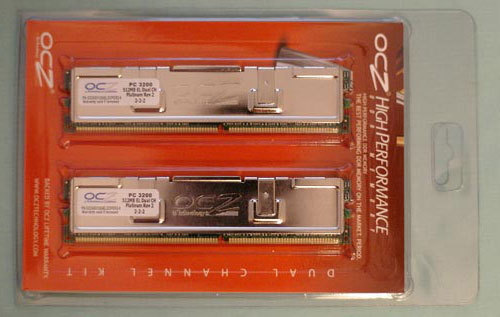
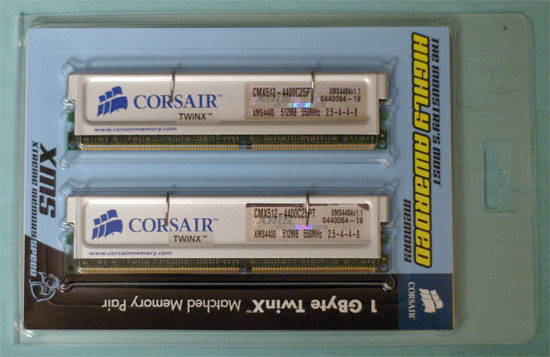
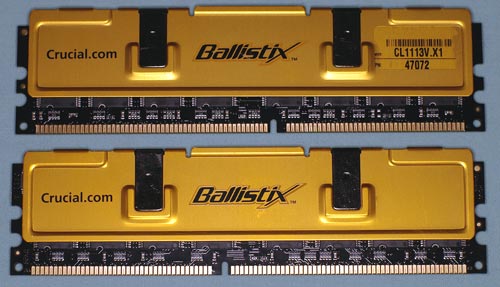
Performance Test Configuration
All four memories were tested on the DFI LANParty nF4 SLI-DR. The new DFI nForce4 SLI and Ultra are the only current production boards that support the voltages required for top VX performance. An OCZ DDR Booster can be used with motherboards without support for high memory voltages. nForce4 is PCI Express, so we used the PCIe version of our standard nVidia 6800 Ultra for testing. Other components remain the same as used in the memory setup in Athlon 64 Memory: Rewriting the Rules.The A64 test bed includes components that have been proven in Socket 939 Athlon 64 benchmarking, such as the Socket 939 4000+ (same specifications as FX53), the OCZ Power Stream 520 Power Supply, and the nVidia 6800 Ultra. We have found the 6800 Ultra to be a particularly good performance match to nVidia motherboards.
All other basic test conditions attempted to mirror those used in our earlier Intel memory reviews. However, test results are not directly comparable to tests performed on the Intel test bed.
| AMD nForce4 Performance Test Configuration | |
| Processor(s): | AMD 4000+ (FX53) Athlon 64 (2.4GHz, Socket 939, 1 MB cache, Dual Channel, 1000HT) |
| RAM: | OCZ EL PC4000 VX Gold (DS) 2X512MB Corsair TwinX1024-4400C25 (DS) 2X512MB Crucial Ballistix (DS) 2X512MB OCZ PC3200 Platinum Rev 2 (DS) 2X512MB |
| Hard Drives | Seagate 120GB SATA 7200RPM 8MB Cache |
| PCI/AGP Speed | Fixed at 33/66 |
| Bus Master Drivers: | nVidia nForce Platform Driver 6.39 |
| Video Card(s): | nVidia 6800 Ultra 256MB PCIe, 256MB aperture, 1024x768x32 |
| Video Drivers: | nVidia Forceware 71.84 Release |
| Power Supply: | OCZ Power Stream 520W |
| Operating System(s): | Windows XP Professional SP1 |
| Motherboards: | DFI LANParty nF4 SLI-DR |
| BIOS: | N4D310p Release (3/10/2005) |
With nForce3 motherboards, we achieved the fastest performance on AMD Athlon 64 chipsets (nForce3, VIA K8T800 PRO) at a Cycle Time or tRAS of 10. However, as we saw in the recent nForce4 SLI roundup, the nForce4 appears to behave a bit differently with memory. In the SLI roundup, we found a tRAS of 7 to be ideal for memory based on Samsung TCCD chips. Therefore, we ran a complete set of Memtest86 benchmarks with only tRAS varied to determine the best tRAS setting for OCZ VX.
| Memtest86 Bandwidth DFI nForce4, Athlon 64 4000+, OCZ VX |
|
| 2 tRAS | 2572 |
| 3 tRAS | 2572 |
| 4 tRAS | 2572 |
| 5 tRAS | 2640 |
| 6 tRAS | 2640 |
| 7 tRAS | 2640 |
| 8 tRAS | 2505 |
| 9 tRAS | 2505 |
| 10 tRAS | 2505 |
| 11 tRAS | 2441 |
| 12 tRAS | 2383 |
These tests are particularly easy to do with the DFI nF4 boards, since memtest86 is built-in to the BIOS. To boot memtest86, you only have to enable it in BIOS and the system will boot directly into memtest86. This makes it very easy to test various memory timings, but memtest86 should be disabled in BIOS when you are ready to boot into the system.
| Memtest86 Bandwidth DFI nF4, Athlon 64 4000+, OCZ 3200 Platinum Rev. 2 |
|
| 4 tRAS | 2191 |
| 5 tRAS | 2191 |
| 6 tRAS | 2242 |
| 7 tRAS | 2191 |
| 8 tRAS | 2191 |
| 9 tRAS | 2141 |
| 10 tRAS | 2092 |
Similar tests were also run on Crucial Ballistix, Corsair PC4400, and OCZ Platinum Rev.2. All 3 memories showed their best bandwidth at a tRAS setting of 6 - just like OCZ VX. Therefore, a tRAS setting of 6 was used for testing wherever possible.
Test Settings
All AMD Athlon 64 processors are unlocked downward, and the FX CPUs are unlocked up and down. This feature allows a different approach to memory testing, which truly measures performance differences in memory speed alone. All tests were run with CPU speed as close to the specified 2.4GHz of the 4000+/FX53 as possible, with CPU speed/Memory Speed increased at lower multipliers to achieve 2.4Ghz. This approach allows the true measurement of the impact of higher memory speed and timings on performance, since CPU speed is fixed, removing CPU speed as a factor in memory performance.The following settings were tested with the OCZ EL PC4000 VX Gold on the DFI nF4 test bed:
- 12x200/DDR400 - the highest stock memory speed supported on K8T800-Pro/nF3-4/SiS755-FX motherboards
- 11x218/DDR436 - a ratio near the standard DDR433 speed
- 10x240/DDR480 - a ratio near the standard rating of DDR466
- 9x267/DDR533 - a standard memory speed used in testing other high-speed memory
- Highest Memory Performance - the highest memory bandwidth and game performance that we could achieve with the memory being tested. This is rarely the highest memory speed that we could achieve; it is normally a lower speed with 1T Command Rate and tighter memory timings.
We ran our standard suite of memory performance benchmarks - Quake 3, Return to Castle Wolfenstein-Enemy Territory-Radar, Super Pi 2M, and Sandra 2004 Standard and UnBuffered.
Test Results: OCZ EL PC4000 VX Gold
| OCZ EL PC4000 VX Gold (DDR500) - 2x512Mb Double-Bank | |||||||
| CPU Ratio at 2.4GHz | Memory Speed | Memory Timings & Voltage |
Quake3 fps |
Sandra UNBuffered | Sandra Standard Buffered | Super PI 2M places (time in sec) |
Wolfenstein - Radar - Enemy Territory fps |
| 12x200 | 400DDR (Stock V) |
2-3-2-6 2.6V 1T (Stock V) |
567.4 | INT 2852 FLT 3000 |
INT 6128 FLT 6082 |
81 | 119.2 |
| 12x200 | 400DDR | 2-2-2-6 3.0V 1T |
572.8 | INT 2918 FLT 3070 |
INT 6154 FLT 6100 |
80 | 120.2 |
| 11x218 | 436DDR | 2-2-2-6 3.1V 1T |
580.2 | INT 3075 FLT 3250 |
INT 6538 FLT 6465 |
80 | 121.4 |
| 10x240 | 480DDR | 2-2-2-6 3.2V 1T |
600.1 | INT 3230 FLT 3402 |
INT 6804 FLT 6726 |
78 | 123.5 |
| 9x267 | 533DDR | 2-2-2-6 3.5V 1T |
601.5 | INT 3479 FLT 3670 |
INT 7140 FLT 7054 |
77 | 124.8 |
| 10x250 | Rated Speed 500DDR | 2-2-2-6 3.2V 1T |
612.2 | INT 3364 FLT 3557 |
INT 7093 FLT 7009 |
75 | 128.4 |
| 10x267 (2.67 GHz) |
Highest CPU/Mem Performance | 2-2-2-6 3.5V 1T |
645.0 | INT 3465 FLT 3630 |
INT 7552 FLT 7460 |
71 | 135.7 |
The top row of Performance results at 2.6V is included as a performance baseline. While VX cannot achieve 2-2-2 timings at stock voltage at DDR400, it can be coaxed easily into 2-2-2 performance at DDR400 with more voltage. With these modules, we reached an extremely stable DDR400 2-2-2-6 at 3.0V. We then maintained 2-2-2-6 timings all the way to DDR538, which required 3.6V for complete stability. The voltage requirements from 3.0 to 3.6 volts were very linear to Memory Speed.
The important results here are rows 2 to 6, where CPU speed is kept at 2.4GHZ and only the Memory Speed is varied. The performance differences you see in that range are a result of Memory Speed and timings only. In the case of VX, where memory timings also remain constant, the true impact of just memory speed can be clearly seen. It is not a huge difference in real-world benchmarks, but the increase is real nonetheless.
However, speed from 400 to 533 is not the only thing that is important with OCZ VX. Please take a look at VX performance in our later performance comparisons. Look at each of these speeds comparing VX to the best AMD TCCD and other memory that we have tested and you will see something very interesting. VX is faster at every speed than competing memory that we have tested. This means all 2-2-2 is not created equal, as VX is faster at every speed than the competition at 2-2-2.
Test Results: Corsair XMS4404v1.1
To be considered stable for test purposes, Quake3 benchmark, UT2003 Demo, Super PI, Aquamark 3, and Comanche 4 had to complete without incident. Any of these, and in particular Super PI, will crash a less-than stable memory configuration.| Corsair XMS4404v1.1 (DDR550) - 2x512Mb Double-Bank | |||||||
| CPU Ratio at 2.4GHz | Memory Speed | Memory Timings & Voltage |
Quake3 fps |
Sandra UNBuffered | Sandra Standard Buffered | Super PI 2M places (time in sec) |
Wolfenstein - Radar - Enemy Territory fps |
| 12x200 | 400DDR | 2-3-3-6 2.6V 1T |
536.5 | INT 2653 FLT 2839 |
INT 6113 FLT 6066 |
82 | 113.2 |
| 11x218 | 436DDR | 2-3-3-6 2.6V 1T |
543.2 | INT 2772 FLT 3023 |
INT 6488 FLT 6419 |
81 | 114.0 |
| 10x240 | 480DDR | 2-3-3-6 2.8V 1T |
553.7 | INT 3037 FLT 3243 |
INT 6723 FLT 6645 |
80 | 115.9 |
| 9x267 | 533DDR | 2.5-3-3-6 2.8V 1T |
562.0 | INT 3196 FLT 3477 |
INT 7084 FLT 7004 |
77 | 117.2 |
| 9x303 (2.73 Ghz) |
Highest Memory Speed | 2.5-4-4-6 2.9V 1T |
620.7 | INT 3403 FLT 3660 |
INT 7742 FLT 7683 |
73 | 131.1 |
| 10x280 (2.8 GHz) |
Highest CPU/Mem Performance | 2.5-4-3-6 2.9V 1T |
626.0 | INT 3409 FLT 3611 |
INT 7799 FLT 7707 |
71 | 135.8 |
Corsair was reviewed in Corsair 4400C25: Taking Samsung TCCD to New Heights. It is very interesting to see that the DFI board opens up performance of the Corsair a bit more, allowing use to reach a high of 303 (DDR606) at 1T compared to the 295 (DDR590) top 1T performance in the past review. However, the fastest performance was achieved at 10x280 at faster memory timings of 2.5-4-3-6 and a higher CPU speed of 2.8GHz.
Corsair selected Samsung TCCD chips for absolute best performance at the top and they succeeded in reaching this goal. The compromise was a bit less performance at DDR400 - at least with the modules that we tested. However, we suspect that the timings used by DFI are not the best match to this Corsair memory, since regular TCCD memory rated at DDR400 outperforms the Corsair at the top - results that are the opposite of what we have seen on other nVidia chipset boards. It looks as if Corsair and DFI could squeeze more performance from this combination with some tweaking.
It is interesting in these test results that the faster 9x303 (2.73GHz) cannot match OCZ VX at 2.67GHz. However, at 2.8GHz (10x280), the Corsair TCCD can roughly match performance of VX at 2.67GHz. It is clear that faster 2-2-2 memory timings of the OCZ VX do matter when it comes to performance.
Test Results: Crucial Ballistix PC3200
Crucial gets a new lease on life on the DFI nForce4 motherboards with memory performance that blows past our previous results with Ballistix on A64.| Crucial PC3200 Ballistix (DDR400) - 2 x 512Mb Double-Bank | |||||||
| CPU Ratio at 2.4GHz | Memory Speed | Memory Timings & Voltage |
Quake3 fps |
Sandra UNBuffered | Sandra Standard Buffered | Super PI 2M places (time in sec) |
Wolfenstein - Radar - Enemy Territory fps |
| 12x200 | 400DDR | 2-2-2-6 3.0V 1T |
547.8 | INT 2922 FLT 3067 |
INT 6112 FLT 6060 |
80 | 115.2 |
| 11x218 | 436DDR | 2-2-2-6 3.1V 1T |
550.2 | INT 3037 FLT 3210 |
INT 6538 FLT 6462 |
80 | 115.6 |
| 10x240 | 480DDR | 2.5-2-2-6 3.2V 1T |
562.3 | INT 3131 FLT 3333 |
INT 6792 FLT 6712 |
79 | 117.0 |
| 9x267 | 533DDR | 2.5-3-3-6 2.8V 1T |
559.8 | INT 3220 FLT 3473 |
INT 7043 FLT 6959 |
79 | 116.9 |
| 10x280 (2.8 GHz) |
Highest CPU/Mem Performance | 2.5-3-3-6 2.9V 1T |
633.7 | INT 3532 FLT 3754 |
INT 7798 FLT 7738 |
71 | 133.8 |
We were able to reach stable memory speeds in the 295 to 300 CPU speed range (DDR590 to DDR600) at slower timings, but the best combination of Memory Speed/CPU Speed/Performance was achieved at 10x280. At 10x280 (2.8GHz) and the still excellent timings of 2.5-3-3-6, Crucial Ballistix turns in performance equivalent to VX at 10x267 2-2-2-6. There is no doubt that the Athlon 64 platform can be a very good match to Crucial Ballistix. When price is considered, Ballistix is still a very attractive choice on the latest nForce4 platforms. It is also interesting that as a memory chip, the Micron chips used in Ballistix are very close in performance to the Winbond chips used in VX at the same timings and speed.
Test Results: OCZ PC3200 Platinum Rev. 2
To be considered stable for test purposes, Quake3 benchmark, UT2003 Demo, Super PI, Aquamark 3, and RTCW had to complete without incident. Any of these, and in particular Super PI and Return to Castle Wolfenstein, will crash a less-than stable memory configuration.| OCZ PC3200 Platinum Rev. 2 (DDR400) - 2 x 512Mb Double-Bank | |||||||
| CPU Ratio at 2.4GHz | Memory Speed | Memory Timings & Voltage |
Quake3 fps |
Sandra UNBuffered | Sandra Standard Buffered | Super PI 2M places (time in sec) |
Wolfenstein - Radar - Enemy Territory fps |
| 12x200 | 400DDR | 2-2-2-6 2.6V 1T |
549.5 | INT 2850 FLT 3045 |
INT 6066 FLT 6034 |
80 | 114.9 |
| 11x218 | 436DDR | 2-3-2-6 2.8V 1T |
546.3 | INT 2893 FLT 3065 |
INT 6452 FLT 6385 |
81 | 114.3 |
| 10x240 | 480DDR | 2.5-3-3-6 2.8V 1T |
550.2 | INT 3016 FLT 3231 |
INT 6709 FLT 6631 |
80 | 115.1 |
| 9x267 | 533DDR | 2.5-4-3-6 2.9V 1T |
554.6 | INT 3101 FLT 3331 |
INT 7026 FLT 6940 |
80 | 116.0 |
| 9x318 (2.86 GHz) |
Highest CPU/Mem Performance | 2.5-4-3-7 2.9V 1T |
649.0 | INT 3562 FLT 3752 |
INT 7828 FLT 7739 |
72 | 136.4 |
The OCZ PC3200 Platinum Rev. 2 was the only memory to achieve its best performance at a 9 ratio - reaching DDR636 in our DFI test bed. This was achieved at the more desirable 1T Command Rate. This level of performance is outstanding, but it is definitely worth noting that OCZ TCCD at DDR636 2.5-4-3-7 performance is roughly equivalent to OCZ VX Gold at 10x267 2-2-2-6. This is particularly interesting, since the CPU speed at 318x9 is 2.86GHz compared to 2.67GHz at 267x10.
OCZ PC3200 Platinum Rev.2 performs very well as the representative of fast TCCD memory. We checked results with G. Skill TCCD and achieved close to the same performance as OCZ with stable performance at DDR630 (315). This represents the kinds of normal variations that you will find in top-performing memory at the highest performance levels.
As impressive as DDR636 sounds, fast memory timings and a fast memory chip can offset both a higher memory speed and a slightly higher CPU speed. The best TCCD can perform just as well as VX, but it required DDR636 and a 119 MHz faster speed to match OCZ VX at 2-2-2-6 timings.
Performance Comparisons
Performance of the OCZ EL PC4000 VX Gold, Corsair TwinX1024-4400C25, Crucial Ballistix PC3200, and OCZ PC3200 Platinum Rev.2 were compared on the DFI nForce4 AMD Athlon 64 platform. While we did not test on an Intel platform, the performance results can also be generally compared to previous benchmark results on the Intel test beds. More results are available in recent DDR memory reviews at:OCZ VX Memory + DFI nForce4 = DDR533 at 2-2-2
Corsair 4400C25: Taking Samsung TCCD to New Heights
PQI & G. Skill: New Choices in 2-2-2 Memory
Athlon 64 Memory: Rewriting the Rules
OCZ 3700 Gold Rev. 3: DDR500 Value for Athlon 64 & Intel 478
Geil PC3200 Ultra X: High Speed & Record Bandwidth
=F-A-S-T= DDR Memory: 2-2-2 Roars on the Scene
Buffalo FireStix: Red Hot Name for a New High-End Memory
New DDR Highs: Shikatronics, OCZ, and the Fastest Memory Yet
The Return of 2-2-2: Corsair 3200XL & Samsung PC4000
OCZ 3700EB: Making Hay with Athlon 64
OCZ 3500EB: The Importance of Balanced Memory Timings
Mushkin PC3200 2-2-2 Special: Last of a Legend
PMI DDR533: A New Name in High-Performance Memory
Samsung PC3700: DDR466 Memory for the Masses
Kingmax Hardcore Memory: Tiny BGA Reaches For Top Speed
New Memory Highs: Corsair and OCZ Introduce DDR550
OCZ PC3700 Gold Rev. 2: The Universal Soldier
OCZ 4200EL: Tops in Memory Performance
Mushkin PC4000 High Performance: DDR500 PLUS
Corsair TwinX1024-4000 PRO: Improving DDR500 Performance
Mushkin & Adata: 2 for the Fast-Timings Lane
Searching for the Memory Holy Grail - Part 2
OCZ EL PC4000 VX Gold, Corsair TwinX1024-4400C25, Crucial Ballistix PC3200, and OCZ PC3200 Platinum Rev.2 were compared at 200x12 (2.4Ghz, DDR400), 218x11 (2.4Ghz, DDR436), 240x10 (2.4Ghz, DDR480), 267x9 (2.4Ghz, DDR533), and the Highest Memory Performance Settings that we could reach. With a constant CPU speed, memory comparisons (except for top performance) show the true impact of faster speed and slower memory timings on memory performance.
DDR400/2.4GHz Performance
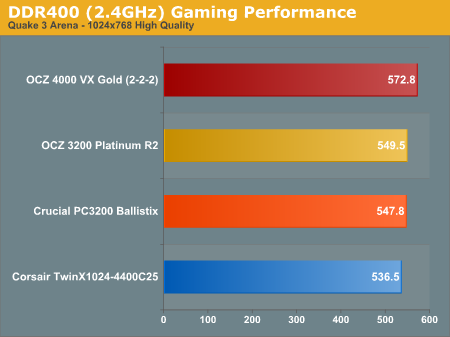
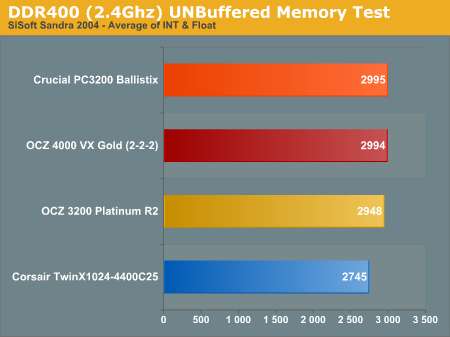
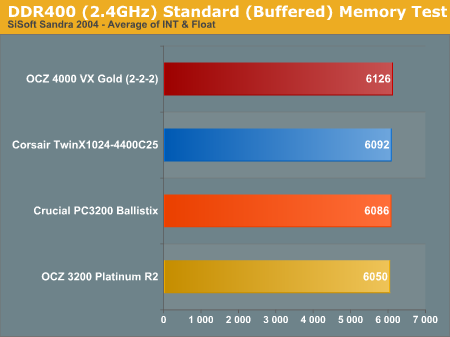
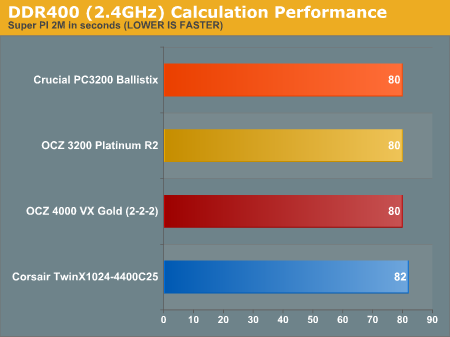
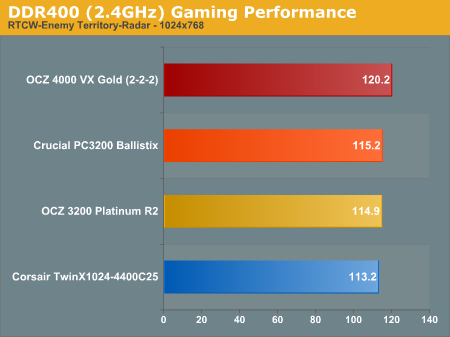
DDR436/2.4GHz Performance
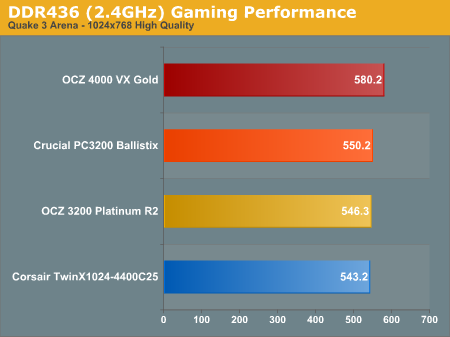
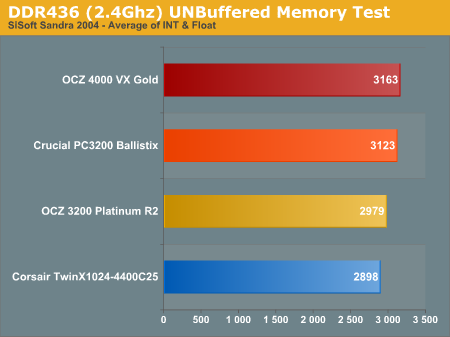
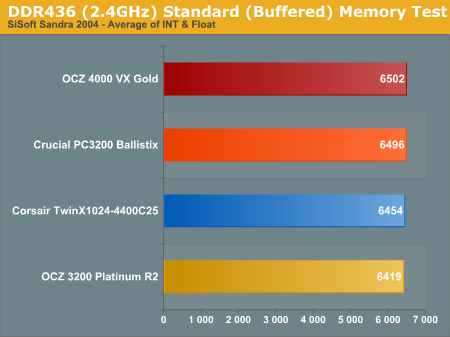
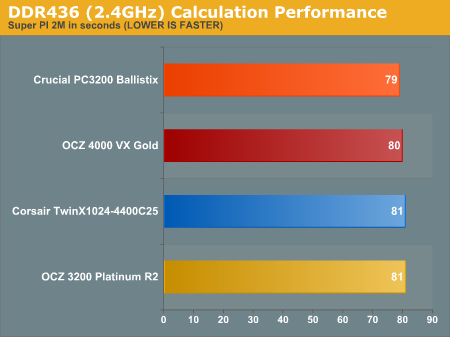
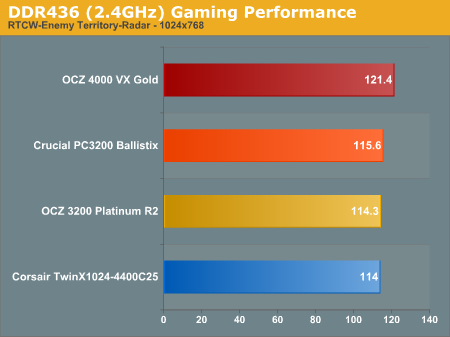
DDR480/2.4GHz Performance
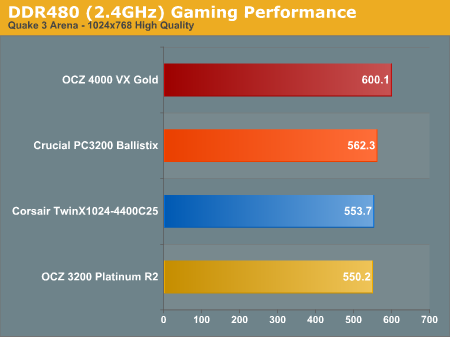
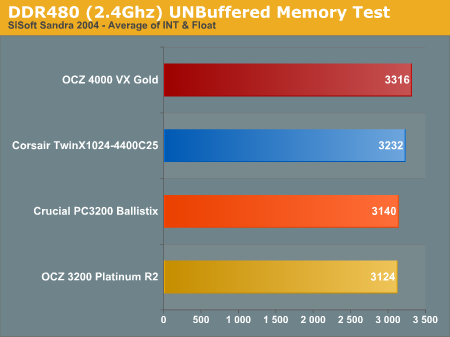
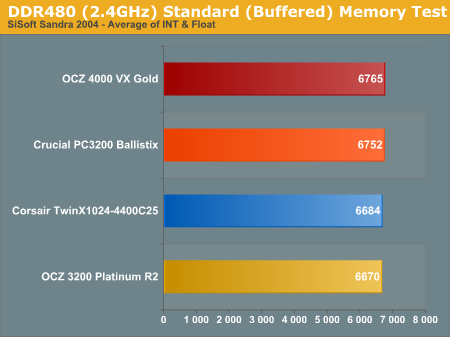
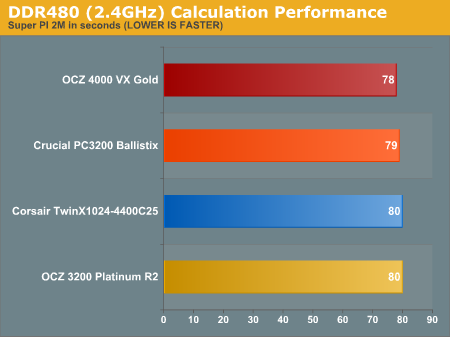
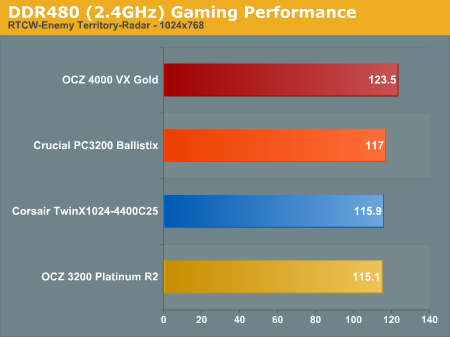
DDR533/2.4GHz Performance
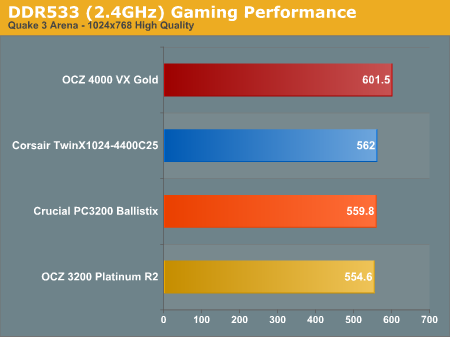
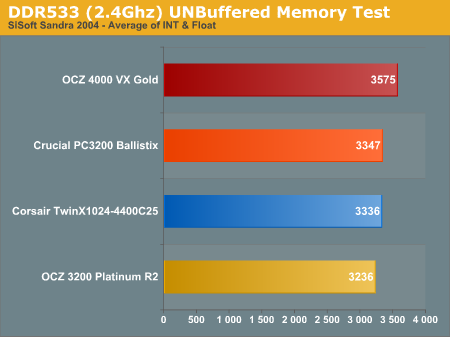
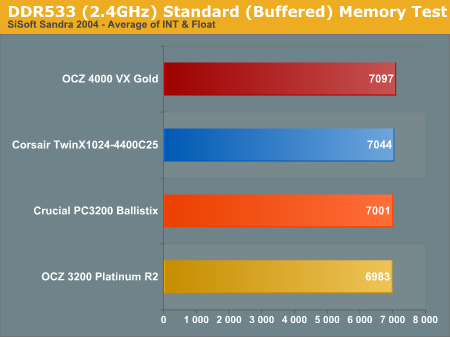
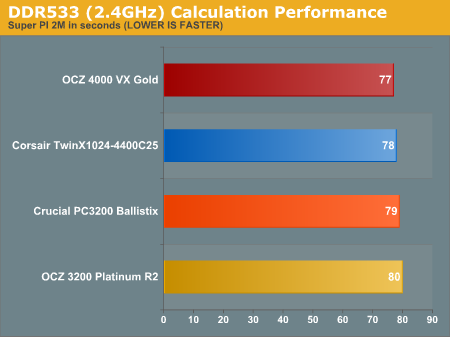
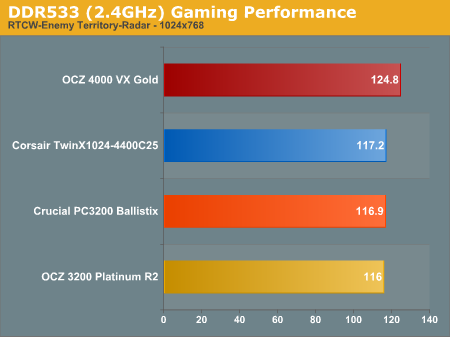
Highest Memory Performance
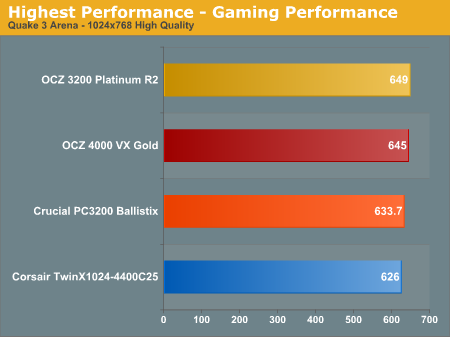
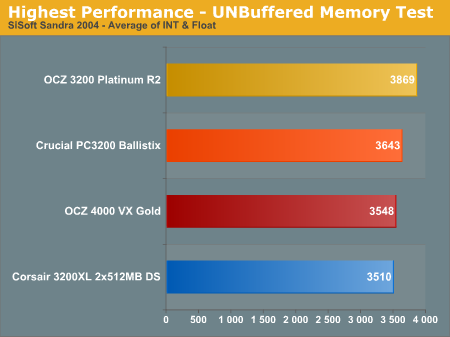
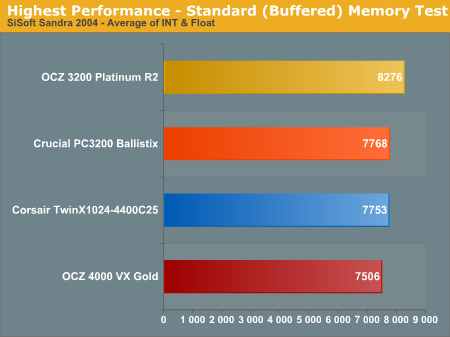
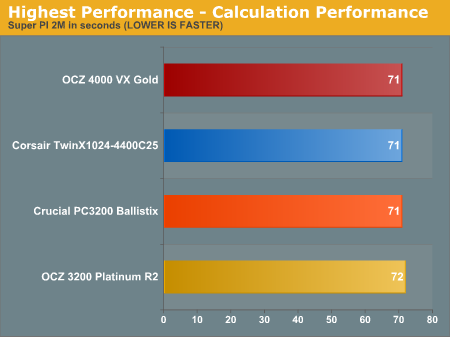
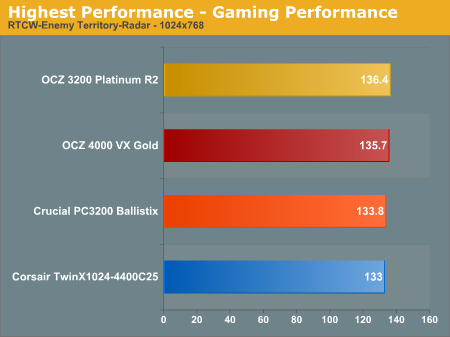
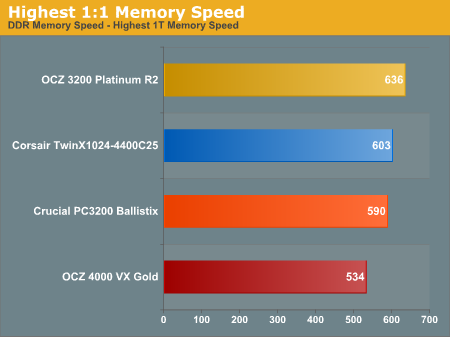
Final Words
Conclusions have not really changed in our update to DDR performance testing on the DFI nForce4. Across the board, OCZ VX is the fastest memory that we have tested when comparing equivalent speeds. However, we also found that other top-performing DDR memory also does better on the DFI nF4. The result is that other top DDR memory is capable of achieving similar performance to VX, although they require higher CPU speeds and memory speeds to offset the slower memory timings and slower performance of the memory chips at the same speed. Results were closer between top competing memory than it appeared in our initial review, and we found this to be almost completely attributable to the better performance of nVidia 71.84 compared to the earlier 61.77 drivers.In the end, the fastest memory that we have tested is OCZ PC4000 VX Gold. Across the range from DDR400 to DDR533, it outperforms any DDR memory that we have tested. This certainly proves that timings do indeed still matter, and 2-2-2 timings combined with a faster memory chip can yield impressive performance levels. The "gotcha" is that you will need a lot of voltage - up to 3.6 volts - to reach these performance levels. The DFI nF4 pair are the only productions boards we are aware of that can supply these kinds of voltages. You can also achieve these voltages on some motherboards by using the OCZ DDR Booster.
There is certainly good news for other top memory on the DFI nF4, however. Almost all of the memory could achieve roughly equivalent performance to the OCZ VX Gold at higher memory speeds and higher CPU speed. TCCD at 318x9 or 280x10 were roughly equivalent to VX performance at 267x10. This required both higher CPU speed and higher memory speed to offset the advantage of fast 2-2-2 timings and fast Winbond chips in OCZ VX. Crucial Ballistix came closest to OCZ VX performance across the curve, since Micron chips do appear more equivalent in performance to Winbond than Samsung TCCD. However, TCCD can reach higher memory speeds, which offsets the Ballistix advantage if your system is capable of the higher speeds. Corsair was particularly fast for a TCCD memory in the 466 to 533 range, exactly where it is targeted. The Corsair did not do as well at the highest speeds on the DFI as it has done on other platforms, but that can likely be fixed with a BIOS revision. In the end, everyone's top performances were pretty comparable.
If you have the means to reach the voltage levels required by VX , then OCZ Gold VX is definitely the fastest memory that you can buy. It tops out at DDR533, but it is just as fast at that speed as TCCD at DDR636 or DDR560 at higher CPU speeds. All 4 memories can achieve similar top performance levels, but OCZ VX Gold does it at the lowest DDR speed and fastest timings. Across its bandwidth of DDR400 to DDR533, OCZ VX Gold is the fastest memory that we have tested. At the top, other top DDR can match VX performance, but they require higher CPU speed and/or memory speed to offset the memory timing advantages of OCZ VX Gold.







